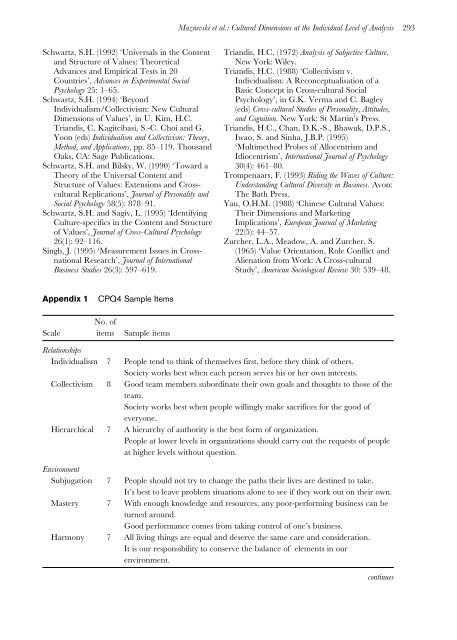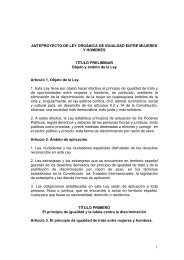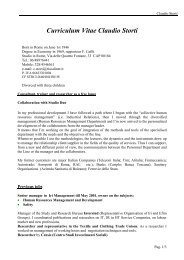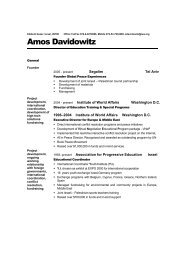292International Journal of Cross <strong>Cultural</strong> Management 2(3)Cowling, M. (ed.) (1998) The Communist Manifesto:New Interpretations. Edinburgh: EdinburghUniversity Press.Davis, S. (1969) ‘U.S. versus Latin America:Business and Culture’, Harvard Business Review88–98.deForest, M.E. (1994) ‘Thinking of a Plant inMexico?’, Academy of Management Executive 8(1):33–40.DiStefano, J.J. and Maznevski, M.L. (2000)‘Creating Value with Diverse Teams inGlobal Management’, Organizational Dynamics29(1): 45–63.Erez, M. and Earley, P.C. (1993) Culture, Selfidentity,and Work. Oxford: Oxford UniversityPress.Hair, J.F. Jr, Anderson, R.E., Tatham, R.L. andBlack, W.C. (1992) Multivariate Data Analysis.New York: Macmillan Publishing Company.Hall, E.T. (1966) The Hidden Dimension. GardenCity, NY: Doubleday.Hall, E.T. (1973) The Silent Language. GardenCity, NY: Anchor Press.Hall, E.T. and Hall, M.R. (1990) Understanding<strong>Cultural</strong> Differences. Yarmouth, MA:Intercultural Press.Hofstede, G. (1980) Culture’s Consequences:International Differences in Work-related Values.Newbury Park: Sage.Hwang, K.-K. (1985) ‘Face and Favour: TheChinese Power Game’, American Journal ofSociology 92: 944–74.Jöreskog, K.G. and Sörbom, D. (1993) LISREL8. Mooresville, IL: Scientific Software.Kim, U., Triandis, H.C., Kagitcibasi, C., Choi,S.-C. and Yoon, G. (eds) (1994) Individualismand Collectivism: Theory, Method, and Applications.Thousand Oaks, CA: Sage Publications.Kirkman, B. and Shapiro, D. (2001) ‘The Impactof <strong>Cultural</strong> Values on Job Satisfaction andOrganizational Commitment in SelfmanagingWork Teams: The Mediating Roleof Employee Resistance’, Academy ofManagement Journal 44: 557–69.Kluckhohn, F. and Strodtbeck, F. (1961)Variations in Value Orientations. Evanston, IL:Row, Peterson.Kras, E.S. (1989) Management in Two Cultures:Bridging the Gap between U.S. and MexicanManagers. Yarmouth, ME: InterculturalPress.Lane, H.W., DiStefano, J.J. and Maznevski,M.L. (2000) International Management Behavior,4th edn. Cambridge, MA: Blackwell.Leung, K. and Bond, M.H. (1989) ‘On theEmpirical Identification of Dimensions forCross-cultural Comparisons’, Journal of Cross-<strong>Cultural</strong> Psychology 20(2): 133–51.Maznevski, M.L., DiStefano, J.J., Gomez, C.B.,Noorderhaven, N.G. and Wu, P. (1997) ‘The<strong>Cultural</strong> Orientations Framework andInternational Management Research’, paperpresented at Academy of InternationalBusiness Annual Meeting.Maznevski, M.L. and Peterson, M.F. (1997)‘Societal Values, Social Interpretation, andMultinational Teams’, in C.S. Granrose andS. Oskamp (eds) Cross-cultural Work Groups, pp.61–89. Thousand Oaks, CA: Sage.Mullen, M.R. (1995) ‘Diagnosing MeasurementEquivalence in Cross-national Research’,Journal of International Business Studies 26(3):573–96.O’Grady, S. and Lane, H.W. (1996) ‘ThePsychic Distance Paradox’, Journal ofInternational Business Studies 27(2): 309–33.Oh, T.K. (1991) ‘Understanding ManagerialValues and Behaviour among the Gang ofFour: South Korea, Taiwan, Singapore andHong Kong’, Journal of Management Development10(2): 46–56.Osland, J. and Bird, A. (2000) ‘BeyondSophisticated Stereotyping: <strong>Cultural</strong> SenseMaking in Context’, Academy of ManagementExecutive 14(1).Parsons, T. and Shils, E.A. (1951) Toward aGeneral Theory of Action. Cambridge, MA:Harvard University Press.Ralston, D.A., Gustafson, D.J., Cheung, F.M.and Terpstra, R.H. (1993) ‘Differences inManagerial Values: A Study of U.S., HongKong and PRC Managers’, Journal ofInternational Business Studies 24(2): 249–75.Ralston, D.A., Holt, D.H., Terpstra, R.H. andKai-Cheng, Y. (1997) ‘The Impact ofNational Culture and Economic Ideology onManagerial Work Values: A Study of theUnited States, Russia, Japan, and China’,Journal of International Business Studies 28(1):177–207.Redding, S.G. (1993) The Spirit of ChineseCapitalism. New York: Walter de Gruyter &Co.Rodríguez Estrada, M. and Ramírez-Buendia, P.(1992) Psicología del Mexicano en el Trabajo.Mexico: McGraw-Hill.Rokeach, J. (1973) The Nature of Human Values.New York: Free Press.Ronen, S. and Shenkar, O. (1985) ‘ClusteringCountries on Attitudinal Dimensions: AReview of and Synthesis’, Academy ofManagement Review 10(3): 435–54.
Maznevski et al.: <strong>Cultural</strong> Dimensions at the Individual Level of Analysis 293Schwartz, S.H. (1992) ‘Universals in the Contentand Structure of Values: TheoreticalAdvances and Empirical Tests in 20Countries’, Advances in Experimental SocialPsychology 25: 1–65.Schwartz, S.H. (1994) ‘BeyondIndividualism/Collectivism: New <strong>Cultural</strong>Dimensions of Values’, in U. Kim, H.C.Triandis, C. Kagitcibasi, S.-C. Choi and G.Yoon (eds) Individualism and Collectivism: Theory,Method, and Applications, pp. 85–119. ThousandOaks, CA: Sage Publications.Schwartz, S.H. and Bilsky, W. (1990) ‘Toward aTheory of the Universal Content andStructure of Values: Extensions and CrossculturalReplications’, Journal of Personality andSocial Psychology 58(5): 878–91.Schwartz, S.H. and Sagiv, L. (1995) ‘IdentifyingCulture-specifics in the Content and Structureof Values’, Journal of Cross-<strong>Cultural</strong> Psychology26(1): 92–116.Singh, J. (1995) ‘Measurement Issues in CrossnationalResearch’, Journal of InternationalBusiness Studies 26(3): 597–619.Triandis, H.C. (1972) Analysis of Subjective Culture.New York: Wiley.Triandis, H.C. (1988) ‘Collectivism v.Individualism: A Reconceptualisation of aBasic Concept in Cross-cultural SocialPsychology’, in G.K. Verma and C. Bagley(eds) Cross-cultural Studies of Personality, Attitudes,and Cognition. New York: St Martin’s Press.Triandis, H.C., Chan, D.K.-S., Bhawuk, D.P.S.,Iwao, S. and Sinha, J.B.P. (1995)‘Multimethod Probes of Allocentrism andIdiocentrism’, International Journal of Psychology30(4): 461–80.Trompenaars, F. (1993) Riding the Waves of Culture:Understanding <strong>Cultural</strong> Diversity in Business. Avon:The Bath Press.Yau, O.H.M. (1988) ‘Chinese <strong>Cultural</strong> Values:Their Dimensions and MarketingImplications’, European Journal of Marketing22(5): 44–57.Zurcher, L.A., Meadow, A. and Zurcher, S.(1965) ‘Value Orientation, Role Conflict andAlienation from Work: A Cross-culturalStudy’, American Sociological Review 30: 539–48.Appendix 1CPQ4 Sample ItemsNo. ofScale items Sample itemsRelationshipsIndividualism 7 People tend to think of themselves first, before they think of others.Society works best when each person serves his or her own interests.Collectivism 8 Good team members subordinate their own goals and thoughts to those of theteam.Society works best when people willingly make sacrifices for the good ofeveryone.Hierarchical 7 A hierarchy of authority is the best form of organization.People at lower levels in organizations should carry out the requests of peopleat higher levels without question.EnvironmentSubjugation 7 People should not try to change the paths their lives are destined to take.It’s best to leave problem situations alone to see if they work out on their own.Mastery 7 With enough knowledge and resources, any poor-performing business can beturned around.Good performance comes from taking control of one’s business.Harmony 7 All living things are equal and deserve the same care and consideration.It is our responsibility to conserve the balance of elements in ourenvironment.continues










